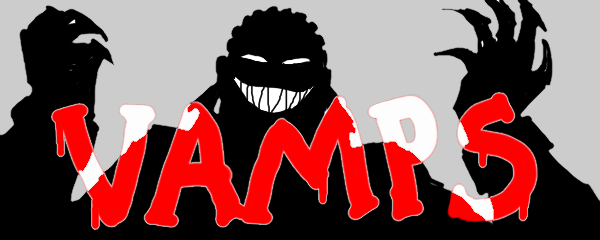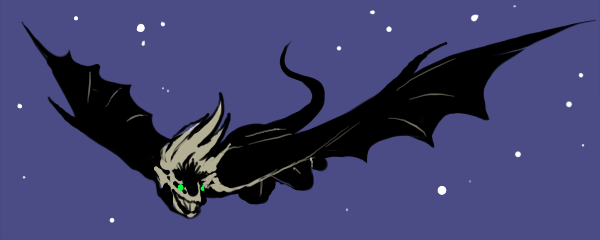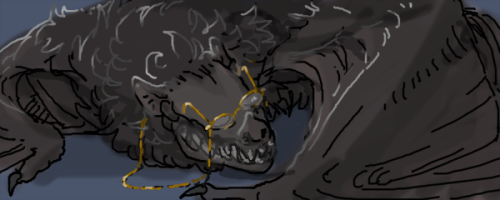
For some reason, vampires ended up being the only concept in EBAMTAR with any kind of structure, so they get their own World Page, the bastards! If you plan on submitting vampire characters or creating content related to them, please make sure to read the information below first.
General
Culturally and physically, vampires of EBAMTAR's version of Earth are linked to humanity, but have existed as a shadow in its background since time immemorial. Each individual has different supernatural traits. In one way these work like genetics; a sire will pass them on to the next generation of vampire they create, but traits may also surface out of the blue, or the traits of the sire manifest in some new way. Whether a vampire's power will increase or decrease with age is also varied. This variability has produced a very diverse vampire population, with each individual having unique characteristics. Regardless of their individial attributes, the six things that every vampire has in common are as follows:
- Human origin (almost all vampires were once humans who were then turned into vampires. Vampires cannot bear young)
- Diet of blood (usually exclusively human blood)
- Weakness to sunlight (varying from "extreme sunburn" to "instantly turn to ash" - some vampires exist who can tolerate the sun without intense harm, but it's a rare trait that the tyrant vampire Queen in particular is famous for)
- Categorised as undead (displaying immortality, mortified traits, or other disconnection to regular patterns of life force)
- Regeneration (unlike some other undead, all vampires have the ability to heal; some at human level, others with supernatural speed)
- Obsession (vampires older than ~100 years will start to experience the symptoms of "vampire senility" (see below))
Traits & Abilities
Most vampires have the strengths of supernatural apex predators: enhanced strength, confidence, reflex, senses, etc.
More unusually, vampires may have abilities that distort the laws of nature; a kind of personal magic force common to many supernatural creatures. Vampires will often have one or two of these abilities, usually subtle ones that aid them in hunting their prey such as hypnosis, supernatural stealth, or the ability to control lesser beasts.
The rarest types of vampire powers are transformational: The ability to become fog, shadow, a winged beast, etc. Most vampires have very mild transformational abilities that allow them to distort their features, lengthen their teeth into fangs, or change the colour of their eyes, but truly dramatic transformations are a rare and powerful ability.
Along with the powers a vampire has, they will also have a set of vampire-specific weaknesses. Like many supernatural beings, vampires are weak to oddly specific things that are unique to each vampire. Vampires most commonly have a weakness to a material, a sunlight weakness to some degree, and a herbal weakness.
Material weaknesses are usually metals or wood. Silver is especially common. The material may literally burn away a vampire on contact like an acid, stop regeneration, or simply have an adverse supernatural effect on their body.
Sunlight weaknesses are universal but vary in severity. To some, the light of the sun is the equivalent force of a thermonuclear bomb, utterly destroying them. To others the light of the sun may merely nullify some of their abilities. To most vampires the sun is a burning torch; crisping flesh away or causing equivalent pain.
Herbal weaknesses are either a supernatural repulsion from certain plants, or an adverse physical reaction to the same. The most common things to affect vampires are usually flowers, such as garlic flower, but can also be tinctures of those plants or something entirely different such as a root. Herbal weaknesses/reactions are not usually fatal, just unpleasant.
Many vampires also respect a supernatural sanctity that does not allow them access to human dwellings. The consequences of entering without invitation vary from mild unease to supernatural expulsion from the abode. The strictness of this "rule" and all its variations varies from vampire to vampire, and some have gotten quite adept at finding the legal loophole in their own personal supernatural law.
Along with these common weaknesses vampires may have a host of other odd little negative vampire traits, such as being repulsed by the sound of bells, fertlized eggs, or inability to sleep anywhere but underground.
Almost all vampires must consume human blood to survive, though some vampires are able to make do with the blood of animals or other supernatural races for a short time. How much blood a vampire needs and how much they hunger for it varies with the individual. Most vampires have some sort of fang, and though most have quite "classic" elongated sharp canines, many variations exist and this is usually something that is at least in part inheirited from the sire. Some vampires are able to conceal their fangs to appear normal; either by the tooth physically sliding in and out of the skull, or by some form of slight transformation. Like and tolerance of the kind of meals they ate as a human again varies from vampire to vampire.

Vampires and Death
Killing vampires is best effected by knowledge of their individual weaknesses. What may be deadly to one may make another merely laugh, but there are two things that will kill any vampire eventually: prolonged exposure to sunlight and starvation. All vampires regenerate their undead flesh, and generally do not require their organs to be functional. As a consequence bullets and even dismembering will usually have no effect beyond causing pain. Drowning/asphyxiation is also ineffective, as well as most kinds of poison or medication that work on humans. Decapitation will halt most vampires in their tracks or kill them. Burning or otherwise dispersing a vampire is a commonly effective way of killing them permanently, but some will reform from ashes/debris, especially when in contact with blood. Regenerative speed in vampires is anything from human healing norm, to instantaneous.
Turning
The process of a human becoming a vampire is different each time. A sire will learn from his/her sire how to perform the act, as the nature of the process is passed down like the abilities. Vampires are usually quite secretive about the process by which the were turned/turn others, and it’s not usually something vampires discuss openly.
The process often involves the transfer of blood, or a secondary fluid called euphemistic names such as "venom". The transformation process in the human invariably involves a "death" of some kind, whether they remain dead for a few seconds, or several days. After turning, the human takes on vampiric traits; some from their sire, some from the sire’s bloodline, and some of their own. They often retain a degree of mortification, whether this is cold skin, lack of pulse, decreased libido/emotions, or a bluish pallor. No vampire needs to breathe, but most still do as simple reflex. Apart from abilities, sometimes purely cosmetic traits are taken from the sire too, such as hair or eye colour, physical build, or even a few personality traits.
The relationship between sire and ward varies in nature, but it is usually a very close bond. It may be a relationship as lovers, as parent and child, or as siblings. In vampires with mental abilities there may be a telepathic bond. A sire and ward know each other better than any other vampires would. The ward is compelled to follow all direct orders by their sire, and sires have great power over their progeny. Wards in turn have the power of knowledge over their sires, as they intimately know their weaknesses and flaws. Thus the relationship between the two is not only of power but necessity, and is not simply casual affection or submission/dominance.
"Vampire Senility"
Also called many euphemistic names such as "the hundred year hole" or "of the age of passion", this strange decay is an apparently unavoidable side-effect of vampirism. It begins to manifest roughly once the vampire has exceeded a normal human lifespan: In order to maintain their mind's awareness and previous personality- their "life" or "soul"- a vampire must channel this into some form of driving force in their everyday lives, usually an obsession of some kind.
This is entirely different for each vampire and can be based on their personal interests, life history, personality, etc. A vampire's life will become intensely focused on a single concept; either physical, such as cats or pictures of castles, or conceptual, such as honour or concealment.
A vampire who does not have an obsession will eventually "lose themselves" and become a shallow husk of a creature; still walking and talking like a human but with a dispassionate absence of depth and personality like a lesser animal. They cease to care about anything but the basic need for blood, and lose their passion for this as well. Although just as cunning, intelligent, and powerful as they may have been previously, these blank vampires lack imagination and adaptability and are often no match for "sane" vampires due to this. Regular vampires have an aversion to these empty people and will drive them away, avoid, or get rid of them if they can.
A vampire's obsession usually starts to appear around their 90th year, as a rough rule of thumb. It's possible for a vampire's obsession to shift to another thing during their undead lifetime, but it is a very rare thing to happen and most vampires will remain solidly obsessive about the same thing until the day they die. The older a vampire gets, the more likely they are to gradually lose their obsession and slowly spiral down into an empty existence, and many of the really old vampires have deliberately held this at bay by actively nurturing their personal obsessions.

Culture
Vampire social structure was formerly based on the strong lording over the weak in anarchic or clan-like structures.
However, over the last few centuries the number of vampires increased to the point that such a chaotic and somewhat random system ceased to function, as territory space in major cities became smaller and more powerful vampires and families began to clash and rub against each other.
All vampires follow an unspoken and instinctual law of concealment from humanity common to many supernatural creatures. Formerly, any vampire found to be breaking this cover was perceived to be a threat to the territory and dealt with by the other vampires around them. With her self-declared rise to monarchy 20 years ago, the vampire Queen Alice brought about a set of absolute laws to avert this type of autonomic "justice", along with the bloodline gangs and territory warfare that resulted from it. The most crucial of these are:
- No vampire may kill another vampire, except the Queen and those under her orders.
- Any vampire may attempt to kill the Queen, and if successful may become the ruling monarch.
- The Queen is obliged to give audience to subjects who wish her intervention.
- Each city will be allocated a number of vampire inhabitants, based on the human population present. Any surplus in the vampire population will leave.
The Queen has a number of powerful vampires under her direct command known as Hazards. Hazards act in her name and are identifiable by the black stone rings they wear.
Under her authority also, an attempt is being made to have a vampire forger (a "Cutter") and at least one surgeon in each major city, to provide vampires with false identities or medical aid should they need them. Vampire presence in law enforcement systems will also gradually be increased.
The Queen's rapid grasp for power has drawn contempt and hostility from many vampires, particularly older and stronger individuals who have already established territories with history that can number in centuries. Her takeover is centered in the United States and the North American continent contains the majority of her supporters, but her self-declared rule remains deeply controversial and a source of political and cultural conflict among vampires everywhere.
Vampires and Humans
There are very few humans who know of the existence of vampires who are not somehow otherwise wrapped up in the supernatural. People such as wizards, necromancers, and Shopkeepers are usually avoided by vampires as they tend to know how to protect themselves from creatures of the night and are anyway often well known in their local supernatural community.
Although rare, "vampire hunters" do exist and have specialised themselves in the eradication of vampires, usually seeing them as dangerous predatory threats to human kind or blasphemous perversions of humanity. Vampire hunters are particularly loathed by vampires but they will not often deal with them directly unless they represent an immediate threat. Although typical of the generally selfish nature of vampires, this has left only the Queen to take organised action against these vampire exterminators, but she has been too distracted with other issues to take much interest in them. Vampire hunters continue to pick off a tiny portion of the vampire population each year.
Along with all supernatural beings, the existence of vampires is known to several high-level and highly secretive branches of human government and other organisations. Vampires are often of special interest due to their once-human nature but remain too dangerous for there to exist any kind of relationship with these shadowy organisations. The Queen has only just begun to enter into direct talks with these people, though their dialogue, if any such thing exists, remains mysterious.
Mutual love between vampires and humans is rare but does occur. The general vampire population takes a very dim view of this and the popular opinion is "kill or turn". Any vampire fighting to love a human who is aware that they are a vampire runs a desperate risk of other vampires taking direct action out of instinct and dislike. As humans are not really protected by any of the Queen's new laws, any intervention under the laws of the monarchy would have to be taken by direct appeal to the Queen.
Vampires tend to avoid or ignore other supernatural beings, concerning themselves mostly with internal issues and the affairs of humans.
Bloodlines
Although every vampire is unique, some bundles of traits show up together often enough to merit having a name of their own.
"Hellhound" Vampire
- Hellhound vampires are a bloodline trait that tends to submerge and reemerge seemingly at random in vampire generations carrying it. They are characterised by the ability to turn into huge hounds or wolves, a weakness to flowers of some kind, and often a weakness to bronze or copper.
Though easily compared to other types of supernatural that become canids, such as werewolves, hellhound vampires are still very much vampires and are undead, harmed by the sun, and require blood.
"Hellhound vampire" is a primarily United States colloquialism and the trait has many different names in many different languages.
Whiteeyes
- Whiteeyes, White-eyes, Whiteyes- however you spell it- are a bloodline of vampires all stemming from one sire known as The Duke. They are widespread throughout the United States of America and specialise mainly in blending in with homeless humans. Each Whiteeye undergoes training after being turned, and the bloodline follows a strict and almost military organisation with rank based on both merit and age within the family.
All Whiteeyes are forbidden from making wards of their own, and because all Whiteeyes are from the same sire they maintain fairly similar traits:
- Super strength
- Burned slowly by direct sunlight
- Fear of dogs
- White-in-white eyes
- Blunt, chisel-like fangs
- Cannot cross running water
- Can sense heat
Although individuals vary, these traits remain consistent enough that, along with their wide distribution and organised system, make them very recognisable.
Whiteeyes are trained carefully in the arts of concealment and hand-to-hand combat. Their hunting strategy is to pick fights with humans, beat them into unconsciousness, and feed off their wounds. A newly turned Whiteeye is not released from training until they can prove they can do this reliably without killing their victim. Whiteeyes are also taught to run before fighting, and to hide. It's very difficult to root out a Whiteeye that has gone to ground, and though they are notoriously skillful at hand-to-hand combat usually the first thing a Whiteeye will do in a conflict is turn tail.
This infiltration among the overlooked of humanity and their already existing infrastructure make the Whiteeyes collectively a natural spy network. Although under the new laws of the Vampire Queen, clan building on such a vast scale is forbidden, the Duke pledged loyalty to the Queen and was granted special sanction. Although they will still seek and divulge information for others for the right price, the network now functions essentially as an intelligence service to Queen Alice and her Hazards.
"Red Death" Bloodline (strigoi) - (created by Dragoonfliy)
- A virulent extended family of vampires with the traits of being both highly infectious and able to transform into a worm-like monster form. Their virulence has earned them the name Red Death, but for centuries they have practiced self-containment; killing their own unstable new members and leaving villages empty as though swept clean by a plague. Grotesque but social, strigoi work and live together in nests, cooperating either as monsters or in the guise of pale, reclusive humans working night shifts. For more detailed information on the Red Death strigoi, click the link above.